 |
The Dark & Silty World of the Steamship Ayuruoca
This article was originally published in the December 1994 issue of Discover Diving magazine.
Shipwrecks provide one of the most wonderful dive sites imaginable to many divers. Anyone with a love of ships and the sea, as well as of maritime history, is fascinated by the tales of heroism and tragedy associated with shipwrecks. Take the adventure of exploring this history first hand, along with a fascinating myriad of oceanic creatures living in every nook and cranny, and you have what many would call a recipe for paradise. For most, however, the vision the word "shipwreck" brings to mind is of the pristine wrecks of Truk Lagoon in the Pacific: gin clear waters, colorful coral and magnificently dramatic sunken ships. But shipwrecks have many faces, and the clear waters of the far Pacific are but one of their masks. There are many shipwrecks whose stories are equally intriguing, and that are equally fascinating to explore, but whom lie in waters far less ideal for diving. The Ayuruoca is one such wreck.
In the waning days of World War II, German submarines lurking off the American coast were no longer the fearful threat they had once been. While there were a few isolated U-boats patrolling our coast, and even a sprinkling of ships sent to the bottom during April and May of 1945, it was a far cry from the early days of the war. During the six months following the American entry into the war, a virtual bloodbath had taken place off the U.S. east coast. A severe shortage of escort and patrol craft, along with a disorganized and inexperienced coastal defense system, had left merchant shipping vulnerable, and the Germans had not missed the opening. One-hundred merchant ships were sunk during the first half of 1942 within the Eastern Sea Frontier, stretching from the Canadian border south to Jacksonville, Florida. It was a tough period for merchant shipping, but by July the sinkings had nearly come to a halt, while a growing number of German submarines were ending up on the bottom instead. It became clear to Admiral Karl Donitz, commander in chief of Germany's submarine fleet, that the easy hunting off the American coast was over: the U.S. forces had matured and Donitz was forced to withdraw his boats in favor of easier hunting elsewhere.
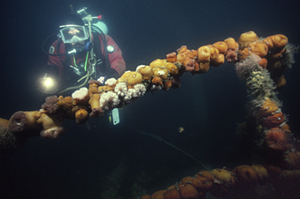 |
| Pat Rooney swims past one of the Ayuruoca's many intact railings |
The single biggest contribution to the end of the American "shooting gallery" was the implementation of merchant convoys. As more and more escort craft became available, a convoy system was slowly introduced along the east coast, eventually bringing merchant sinkings down to a tolerable level. In contrast to the 100 ships sunk in the Eastern Sea Frontier during the first six months of the campaign, only fifteen ships were lost in these same waters during the remaining three years of the war—a remarkable testimony to the effectiveness of the convoy system. As the war wound down to its inevitable conclusion in the early days of May, 1945, hostilities in the Atlantic ceased; the German high command recalled its U-boat fleet and free navigation of the seas was once again assured. Yet transatlantic convoy operations continued throughout the month before finally coming to an end on May 28th.
With convoys discontinued, ship sailings quickly assumed the routine status they had enjoyed prior to man's greatest armed conflict. But the business aspect of the war had not yet been entirely completed—contracts had been signed and deals had been made, and there was still war materiel as well as merchant goods to be delivered. The 6,872 ton Brazilian freighter Ayuruoca was outbound from New York to Rio de Janeiro, carrying a general cargo of lend-lease materials, when she met her end on June 10th, 1945. Had she sailed only two weeks earlier she would have been forced to sail in convoy, but with the war over she found herself leaving port alone for the first time in three years.
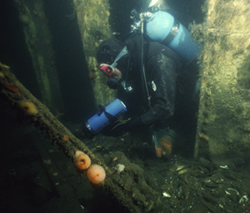 |
| Jeff Pagano searching for treasure inside the ship's collapsing interior |
As the big Brazilian freighter glided out of New York Harbor and into the busy shipping channels leading into the open ocean, she found herself confronted by a heavy veil of fog. Although peace had returned to the world, only the danger of U-boats had disappeared, for ship captains still had to contend with the natural dangers that had plagued them for centuries, and fog was one of their most notorious adversaries. Fifteen miles south of the Ambrose lightship the Ayuruoca was assaulted without warning and split neatly in two; the attacker was not a German U-boat, however, but the inbound Norwegian cargo ship General Fleischer. The two-halves of the severed Ayuruoca managed to stay afloat for nearly half-an-hour, allowing all but one of her 66-man crew to make their escape in the ship's lifeboats. A plethora of now-idle escort vessels was dispatched to the scene in order to rescue the crew; among those involved was the Coast Guard cutter Icarus, made famous by her sinking of the German U-352 three years earlier. The 65 survivors of the Ayuruoca were picked up and taken aboard the sub chaser SC-1057, where they solemnly watched as the two halves of their ship slowly slipped beneath the waves.
With her sinking, the hulk that was the Brazilian freighter Ayuruoca had become just one more menace to navigation; the wreck location was buoyed and she was nearly forgotten. Six years later the derelict ship was cleared to a depth of "at least 122 feet" by wire drag, and an obstruction symbol was placed on local marine navigation charts. But her identity had drifted into obscurity, and she was listed in official paperwork simply as an "unknown wreck."
Some twenty years after the war's end, a group of adventurous east coast wreck divers began diving a huge freighter perched on the edge of the "mudhole" in the New York Bight. The wreck was known then only as the "Oil Wreck," so-called because of a slow but steady stream of oil trickling towards the surface. The area known as the "mudhole" is really an extension of New York's Hudson River—a deep valley carved into the bedrock of the continental shelf during one of earth's ice ages. Now filled with thousands-of-years of muddy river effluent, the water here is deep, dark and murky.
The divers, members of the Eastern Divers Association, were fascinated with the huge wreck. She was sitting upright on the bottom and perfectly intact—except that she had been cut neatly in two! Research efforts by Mike deCamp produced a clue to the ship's identity when he ran across a tiny newspaper article in the New York Times, dated June 12, 1945. The article told of a collision between two ships fifteen miles south of Ambrose lightship—one of the ships, the Brazilian freighter Ayuruoca, had been sunk. The collision seemed to fit since the wreck they had been diving had obviously been cut in half, so deCamp ordered several photographic enlargements of the ship's bridge section from the Mariners' Museum in Newport News, Virginia. Taking the photographs down on the wreck with him, he found he could match every detail found on the wreck with the photograph—it seemed that the mystery had been solved. Later, John Dudas brought up a clock that George Hoffman had discovered earlier in the ship's bridge section. The clock had been made by the Chelsea Clock Works and had a serial number; company records indicated that the clock had been sold to the Lloyd Brasileiro shipping line and had been installed on their vessel Ayuruoca. The identity of the "Oil Wreck" had been confirmed.
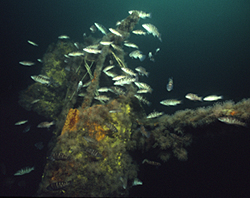 |
| The top of one of the ship's masts |
Today, the Ayuruoca, or "Oil Wreck" as she is often still called, sits undisturbed and largely unchanged where she sank nearly fifty years ago. The often murky water and her depth, some 150 feet to her main deck, keep most divers away. For sure, diving in the un-inviting waters of New York's "mudhole" is an acquired taste, but for those who dare to explore her depths the experience is a unique venture into an alien world.
In an area of the country known for its arduous wreck diving, the Ayuruoca is unique in that it is one of the few wrecks that still looks like a ship. Her two halves sit almost perfectly upright, towering above the muddy bottom in a magnificent state of preservation. Her four masts, although broken at the level of their crow's nests by a wire drag in 1951, rise to within 90 feet of the ocean's surface. These four towering spires provide a link with the surface world above, for their tips reach upward into the realm of sunlight and often abound in schooling fish; but below, the masts are rooted in an eerie world of perpetual twilight. The soupy outflow of the mighty Hudson River, combined with a bottom of black river silt deposited over eons, serves to cast a cloak of darkness into the depths of the nearby "mudhole," and it is the penumbra of this dark shadow that casts its eerie veil over the wreck of the Ayuruoca.
The massive ship once stretched 468 feet in length, but now her two halves lie some 50-100 feet apart. The ship was severed just behind her bridge superstructure in the collision with the General Fleischer, but other than the twisted steel hull plates in the immediate vicinity of the collision there appears to be no damage to the vessel. The top of her lofty superstructure materializes out of the gloomy ocean depths 110 feet down and, save for the wooden wheelhouse that once looked out over her decks, is structurally complete. Walls, companionways, rooms and stairways are all there for a visiting diver to explore. An abandoned fishing net forms a shadowy curtain as it drapes over one side of the superstructure, lazily fluttering in the gentle current as if the ship were still underway. Bushy hydroids and clustering sea anemones transform the ship's railings into a plush, velvety rope, not unlike those defining a theater line. Inside, empty rooms, filled with blackness, display the decay of half-a-century; fallen beams and rotting timbers lie half buried in a deep accumulation of the grey silt that continually drifts through the hollow skeleton like airborne pollen.
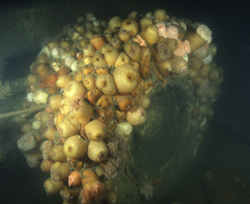 |
| A truck tire studded with anemones |
 |
| The steering wheel of one of the ship's trucks—war materiel destined for Europe |
Down below, on the ship's fore deck, sheltered from the fading rays of sunlight by the towering bridge structure, two trucks squat down in the dark on flattened tires. Lashed to the deck as part of the Ayuruoca's cargo of lend-lease materiel, the vehicles have withered in an element for which they were never intended—yet they are still recognizable to a discerning eye. Grills and bumpers glare out from beneath a corroded and overgrown engine; heavily treaded tires are now studded with tall, spindly sea anemones. A tiny steering wheel, dripping with abandoned fishing line and sea anemones, extends a lonely salute from its perch on a long, slender steering column. The ship's broad deck stretches forward into the dark gloom, punctuated at regular intervals by the deep black caverns of her cargo holds. Dark and forboding, the square hatchways open into a mysterious world of dimensionless black—an empty, opaque void without reference that swallows light mercilessly.
Across the debris-littered breach in her hull lies the Ayuruoca's after-half. A long, low-lying deck house abruptly plunges into the depths where the ship was severed in two; a wake of torn steel plating still shows the path taken by the General Fleischer. The flat expanse of the deck house roof sags inward, trying to crush the crew's living quarters below. Two long corridors run along the ship's axis, from the collision point to the after end of the deck house—long tunnels of blackness burrowing through the ship's interior. Along each corridor doorways open into rooms on either side; rooms filled with deep silt and broken furniture, collapsing sinks and shelves, a scattering of china dishes—remembrances of the men who once lived and worked here. Round circles of glowing green mark the ship's exterior walls, where portholes admit the dim prevailing light from outside. Tiny square hatches drop through the floor into an unknown abyss below—miniature versions of the huge cargo hatches interrupting the long after deck.
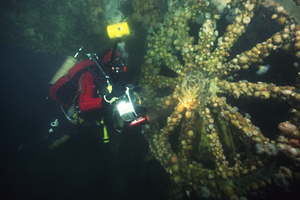 |
| Brian Skerry examines the huge wooden helm on the ship's aft deck |
Outside, on her main deck, tangled webs of thick monofilament enshroud everything like invisible coils of razor-wire, a testament to the rich fishing grounds found in the depths surrounding the wreck and the nearby "mudhole." Between cargo hatches sit huge winches and collapsed mast wreckage, along with more of the eerie trucks, hunkered down like giant insects poised to strike. While decay has set in here, little else seems changed since the day of her sinking; pulleys and tools still sit on shelves inside tiny deck houses near her stern. And everywhere there is silt—fine and grey, it covers every surface like dust in some ancient attic, stirring into opaque clouds at the slightest touch. The Ayuruoca appears like a fossilized ghost from another era; swimming along her decks is like a journey through a strange dream world, somewhere between sleep and awakening.
Approaching the extreme stern, an apparition appears out of the drifting fog of sediment—a massive helm wheel stands huddled beneath a towering gun platform. A full six feet in diameter, the spokes of the old wheel appear gnarled as plump, round sea anemones cling tightly to weathered wood; in the center a brass hub is covered by a thin veneer of yellow sponge. A circular gun tub forms a canopy over the helm, sheltering the wheel from any errant sunlight that might filter down from above. A large gun faces aft, sitting on the edge of darkness and peering out into the twilight world of the depths from its castle-like fortification. Near the breech stand two corroded steel cases, filled with neatly stacked ammunition canisters—a token armament intended as a defense against the wolves of an oceanic war; a war that the Ayuruoca survived, only to meet her end in a mundane collision in the fog.
All images, text and content Copyright © Bradley Sheard. All rights reserved.